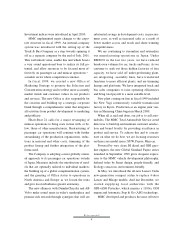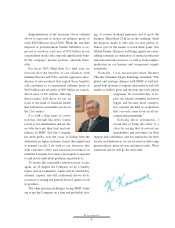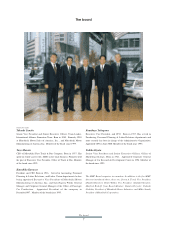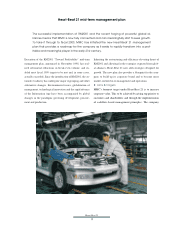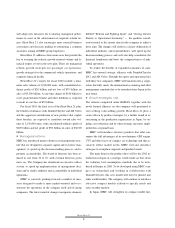Mitsubishi 2000 Annual Report Download - page 16
Download and view the complete annual report
Please find page 16 of the 2000 Mitsubishi annual report below. You can navigate through the pages in the report by either clicking on the pages listed below, or by using the keyword search tool below to find specific information within the annual report.
14
On the analyst's couch: 2000
14
ever, individual operations must pay their own way, be
self-supporting in all respects. The alliance with AB
Volvo, whom we happened to be collaborating with in
our NedCar operation in the Netherlands, came first be-
cause the AB Volvo management thought very much
along the same lines as ourselves.
When we started to think about a passenger car al-
liance, there was a wide choice in terms of potential syn-
ergies but we concluded that teaming up with
DaimlerChrysler would bring the greatest benefits. The
3-liter car is one area that holds great promise in terms of
exploiting synergies stemming from our alliance with
DaimlerChrysler. For instance, there is little call for the
3-liter car in the United States, the introduction in
Europe of the voluntary fuel consumption standards slat-
ed for 2008, points to considerable potential demand in
Europe.
We made inquiries, both direct and indirect, to gauge
interest on the part of other auto makers. The result was
that the company that showed the most interest, that
shared our views and that also promised the greatest syn-
ergies was Daimler. Again from the point of view of syn-
ergies, Chrysler obviously has many years experience in
the United States and we so concluded that synergies
would be fastest to materialize there. We were faced with
an end-of-March deadline in connection with NedCar
and so were required to reach a conclusion before then.
Under the terms of our agreement with Volvo Car, we
shall be continuing to operate NedCar as we have been
doing up to 2004.
H: Would you tell us a little about the Z Car?
K: We're thinking about the type of car that is set to form
the largest volume segment in the near future. In terms of
engine size, it will be somewhere between 1-liter and
1.5-liters. If you ask me to describe the segment more
precisely, I would say it gives clearer definition to what
is currently referred to as the 3-liter (3-liter/100 km) class
in Europe. The image we have at the moment is of a car
that anticipates the European 3-liter car of around the
year 2007, 2008. Being compact in size, we are looking
to develop it to a totally novel concept, to incorporate
some totally new features. The 3-liter car is basically still
a prototype and has not yet gone into mass production.
The Z Car is for mass production. The relatively low
sticker prices in this category mean that we have to make
the Z-Car a de facto standard. This means we will be
looking to ensure it is executable to the same concept in
as many regions as possible. We're looking to produce a
car to a new concept, one that will become a new de fac-
to standard.
S: Would you give an assessment of the degree to which the
RM2001 targets have been met, and then describe the
targets in the new Heart-Beat 21 management plan?
K: On an item-by-item basis, we have actually exceeded
most RM2001 targets. We have exceeded target in lower-
ing break-even volumes, and are right on target with cost
reductions. In terms of shutting down or rationalizing as-
sembly lines, we have done what we said we would. We
are also on track in trimming our asset portfolio and are
actually ahead of schedule in some areas. We are also
Noriaki Hirakata


